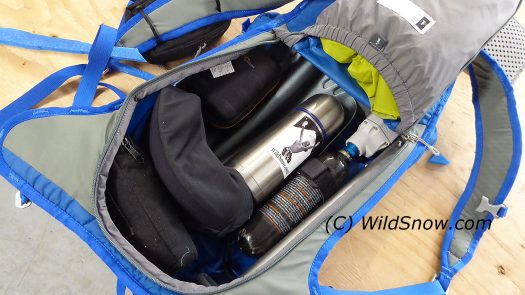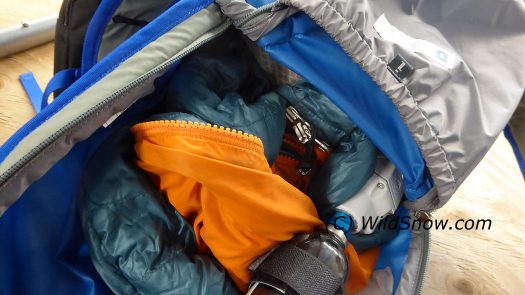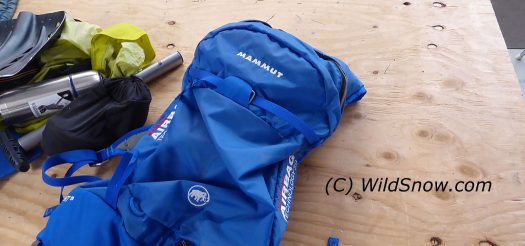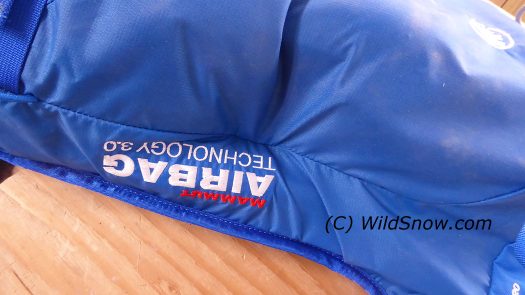(Please note, regarding our use of the Mammut carbon cylinder that’s only retail available in Europe. Quite a few of our readers are in Europe, and the cylinders can be brought to North America from Europe on direct flights. So we chose to configure these packs with the lightest weight option possible.)
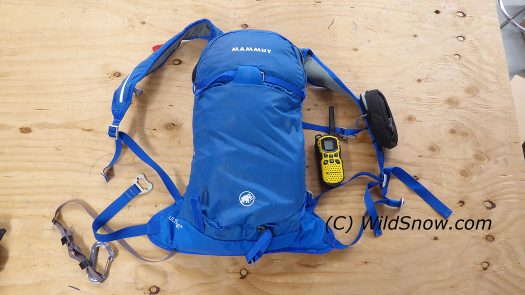
The object at hand, Mammut Ultralight 20 super minimalist airbag backpack. 2-way radio for scale, I carry it in the vest pocket of my layers. Black object on shoulder strap is a camera bag.
Weight 1592 grams with carbon cylinder. Airbag backpack. Need I say more? Sure, it’s a blog, more shall be said.
Ever since Mike Arnold did our initial testing of the Mammut Ultralight 20 RAS (Removable Airbag System) I’ve been eager to configure one of these rigs for my own real-world use. I’m a “normal” user of this sort of rucksack, since my tours are generally more moderate than Mike’s, and I don’t do as much hardcore ski mountaineering as I used to. Well, I got it done — I’ve been out with the little blue fellow for a few days of powder skiing in Colorado avalanche terrain.
Goal was to configure (fancy word for “load”) the Ultralight 20 for a specific style of ski touring. That where you rarely strap your skis to the pack, carry minimal water, and don’t need arctic clothing. In other words, moderate ski touring in terms of weather and objectives. (If a larger pack is needed Mammut boasts their Light 30, which is quite commodious while being reasonable in mass, 1736 without cylinder, 2054 with 318 gram carbon cylinder. **See below for more weight informations.)

The load. Clockwise from top left: Strafe Recon shell, Mammut Alugator Light shovel, with sharp edges ground off, downsized thermos, FRS radio that gets carried in vest pocket included for scale, goggles in soft black case, Buff, tiny repair kit, spare lighter that wouldn’t fit in repair kit, satphone. Added on the up, puffy and possibly fleece layer rolled up and strapped to outside. Clearly, not much. (A small “Euro” style avalanche probe fits in as well, not included in this photo.)
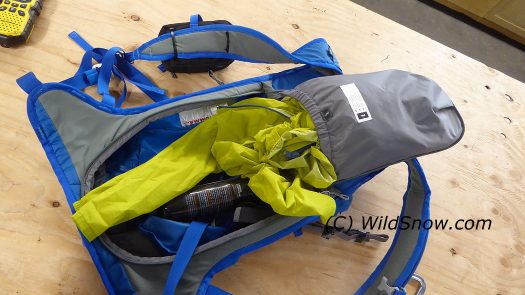
I tried stuffing the Strafe into this compartment behind the back flap, but it created too much of a baby bump. This pack is of course a panel loader, via a zippered flap on the rear, behind your back.
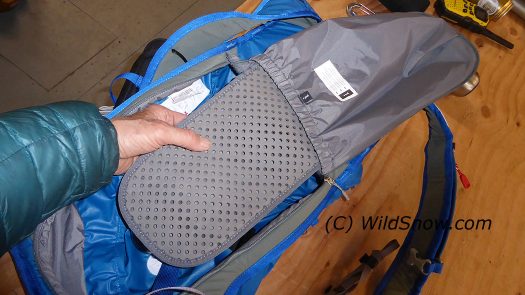
Compartment had this small chunk of foam, a bit of a joke. Weighs 18 grams for those of you who care about those sorts of things. While packing, my biggest problem was figuring out how to load all those hard edged items without them digging into my back. I finally acquiesced and cut a larger foam pad that covers all the pack contents, as a layer just behind the rear zipper flap. My DIY foamie is 31 grams. I really feel those additional 13 grams on my poor misbegotten shoulders, but now I’ve got a piece of foam I can actually sit on instead of waving around and asking “what is this thing for?”
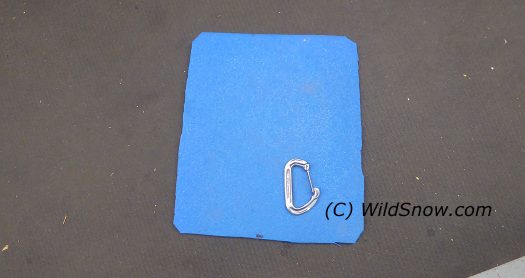
My home build foam backpad. Took several hours and six trips to the outdoor store to get it perfect. Carabiner for scale, but also used to quick-clip the pack’s leg strap.
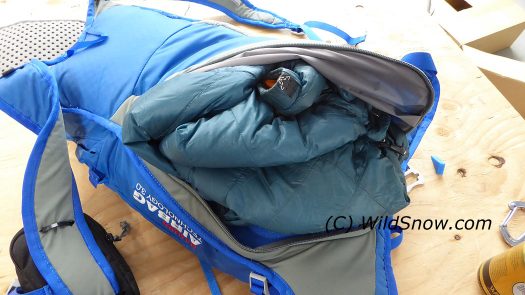
Where does that puffy go? Turns out I wasn’t utilizing quite a bit of space up next to the airbag storage. Careful packing got the puffy stowed nicely utilizing that area. I then layed the Strafe over some of the gear, and covered with my DIY foamie.
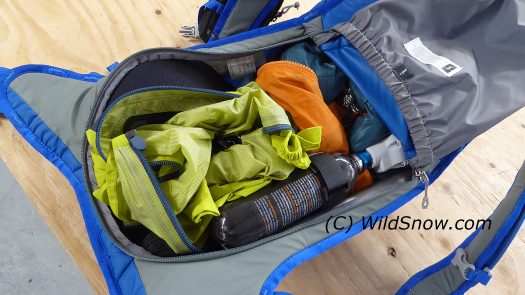
Final build, before the foam layer. Note how my puffy is almost totally stowed in the upper area. Carbon cylinder is key to using this pack for actually ski touring as the small amount of added interior cargo space takes you over the top. Oddly enough, the velcro strap that secures the cylinder is miss-located and results in the side of the pack being dimpled in. Removing the cylinder strap got me a few more cubics of volume.
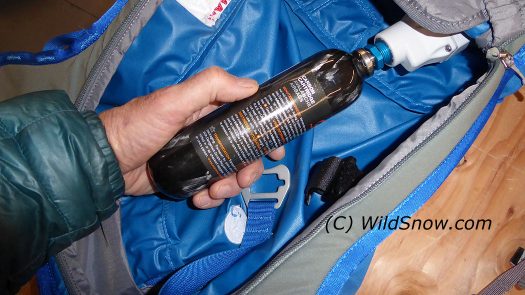
The now legendary carbon cylinder. One thing I like about the Mammut system is that screwing in the cylinder cocks the firing pin. No fuss. Be sure to firmly tighten cylinder to the point where you can’t see the rubber gasket, then inspect occasionally to be sure it’s not coming undone. I wasn’t careful enough with this, mine worked its way out during my first tour-test.
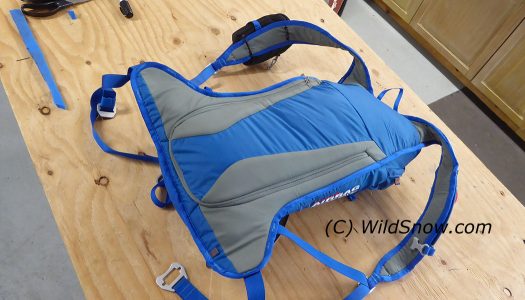
Loaded up with everywhere to go. Camera bag on shoulder strap is secured with a few zip ties (see this blog post.)
Conclusions:
I see no problem in using the Ultralight 20 within its design parameters. Meaning moderate ski tours in moderate climate, or perhaps for activities such as heli skiing when you carry minimal gear. The admittedly small volume is inappropriate for anything more.
Further, I don’t recommend carrying skis on this pack. Doing so without damaging the thin fabric would require utmost care with lashing as well a judicious padding, things most people would not have the patience nor time for.
The RAS system is wonderful. For example, I’m thinking for a hut trip I can carry the 30 liter pack on the access trail, with the 20 packed inside sans airbag system. At the hut, switch the RAS to the 20 for day tours. Main takeaway here is that with the RAS removable airbag system, you could own this as well as the 30 liter and swap the balloon plumbing back and forth accordingly. Or just go with the 30 if what you’re seeing here isn’t appropriate for your style of skiing.
The 20 rode well and fit my 180 cm body perfectly. The leg strap has an odd adjustment system that ended up in a big loop when I opted to clip with a carabiner. I taped up the excess webbing with a few chunks of duct tape. Only thing I’d like to see added is a small “sunscreen” pouch on the waistbelt (the 30 does have that feature). Whining and moaning about adding anything more (can’t we have…tool pockets!?) is just futile fighting against what is clearly an ultra-minimalist design philosophy — a build style we’ve been waiting for years to enjoy in an airbag backpack.
(The “worldwide” Mammut aluminum cylinder weighs 656 grams so it comes at a penalty of 338 grams, 12 ounces. That’s major with a pack this light. Further, the worldwide cylinder takes up noticeably more space and probably makes the Ultralight 20 impractical for most backcountry skiers.)
Shopping for Mammut airbag backpacks appears to be confusing, but I found a solid source for the Ultralight 20. Check out this link at Backcountry.com. I couldn’t find the current Light 30 at Backcountry, but did find it on the REI site.
WildSnow.com publisher emeritus and founder Lou (Louis Dawson) has a 50+ years career in climbing, backcountry skiing and ski mountaineering. He was the first person in history to ski down all 54 Colorado 14,000-foot peaks, has authored numerous books about about backcountry skiing, and has skied from the summit of Denali in Alaska, North America’s highest mountain.

